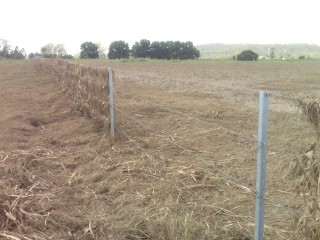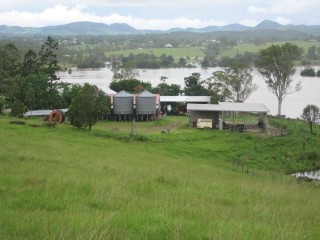 The use of longer and stronger steel fence posts at closer spacing intervals has given a Gympie district grazing family a fencing solution that withstood the ultimate test – a January flood submerging the property's river flats paddocks to a depth of six metres.
The use of longer and stronger steel fence posts at closer spacing intervals has given a Gympie district grazing family a fencing solution that withstood the ultimate test – a January flood submerging the property's river flats paddocks to a depth of six metres.
Andy Mulholland and family’s southeast Queensland grazing property, Widgee Crossing, has a 3km double frontage to the Mary River and the property’s new fence completed last year was the first in history to have emerged undamaged from such a big flood.
“In the past, traditional Y-shaped star pickets would get bent over and even some of the timber posts would get pulled out in a decent flood. So we decided to go with Waratah GalStar Extreme posts when we replaced the fencing on the river frontage cultivation country last year,” Mr Mulholland said.
Hot dipped galvanized posts 150mm longer than the traditional Y-profile steel pickets were utilised in the fence upgrade. When strung with four strands of Waratah 1.8mm high-tensile Longlife barb, they literally stood up to the record-breaking January flood.
“When the water receded all we had to do was take the debris off the fence-line, instead of rebuilding or repairing like we’ve always had to do in the past. The fence didn’t move at all,” Mr Mulholland said
 The Widgee Crossing property has been in the same family since the early 1870s and Mr Mulholland said he hoped the fencing upgrade would see an end to the time-worn family tradition of flood fencing repair after each major river rise.
The Widgee Crossing property has been in the same family since the early 1870s and Mr Mulholland said he hoped the fencing upgrade would see an end to the time-worn family tradition of flood fencing repair after each major river rise.
“Fencing is an expensive piece of infrastructure on any cattle property and if you’re losing sections to flood every five or six years, replacing it becomes a big regular capital expenditure and time commitment. It’s now hopefully one we won’t have to make again,” he said.
Mr Mulholland said he had used Waratah fencing materials for many years, but this was the first significant investment in fencing he’d built solely using Waratah products in conjunction with round timber strainer posts.
Last year he sounded out Waratah’s territory sales manager for southern Queensland, David Sorley, about using Waratah materials to replace existing fences that were not expected to withstand everyday pressure from beef cattle, let alone the next flood.
“The black imported steel pickets we have used in the past were 165cm long and we drove them in the ground about 45cm. The silver GalStar Extreme posts were 180cm long and we drove those in about 60cm. By increasing the depth the post was driven by one third, its resistance to overturning was significantly increased, despite the flood debris pressure” Mr Mulholland said.
David Sorley worked with the Mulhollands using a quantities calculator to work out GalStar post spacings and quantities of wire required as well as the performance capabilities for the river frontage application and specifications of each product.
As a result the project used post spacings closer than normal at four metres, to withstand the pressure from the debris, which had worked well in the January flood.
- Click on photos here for an expanded view
